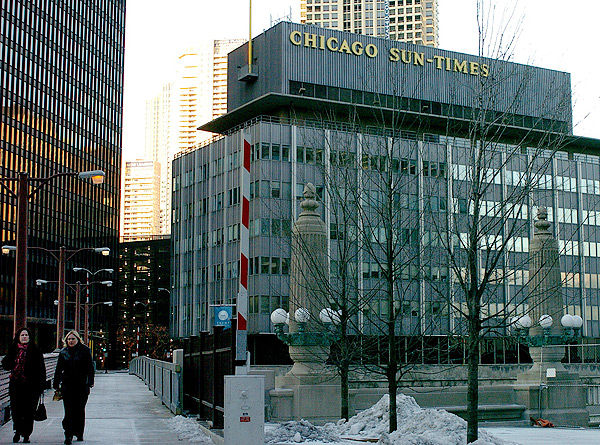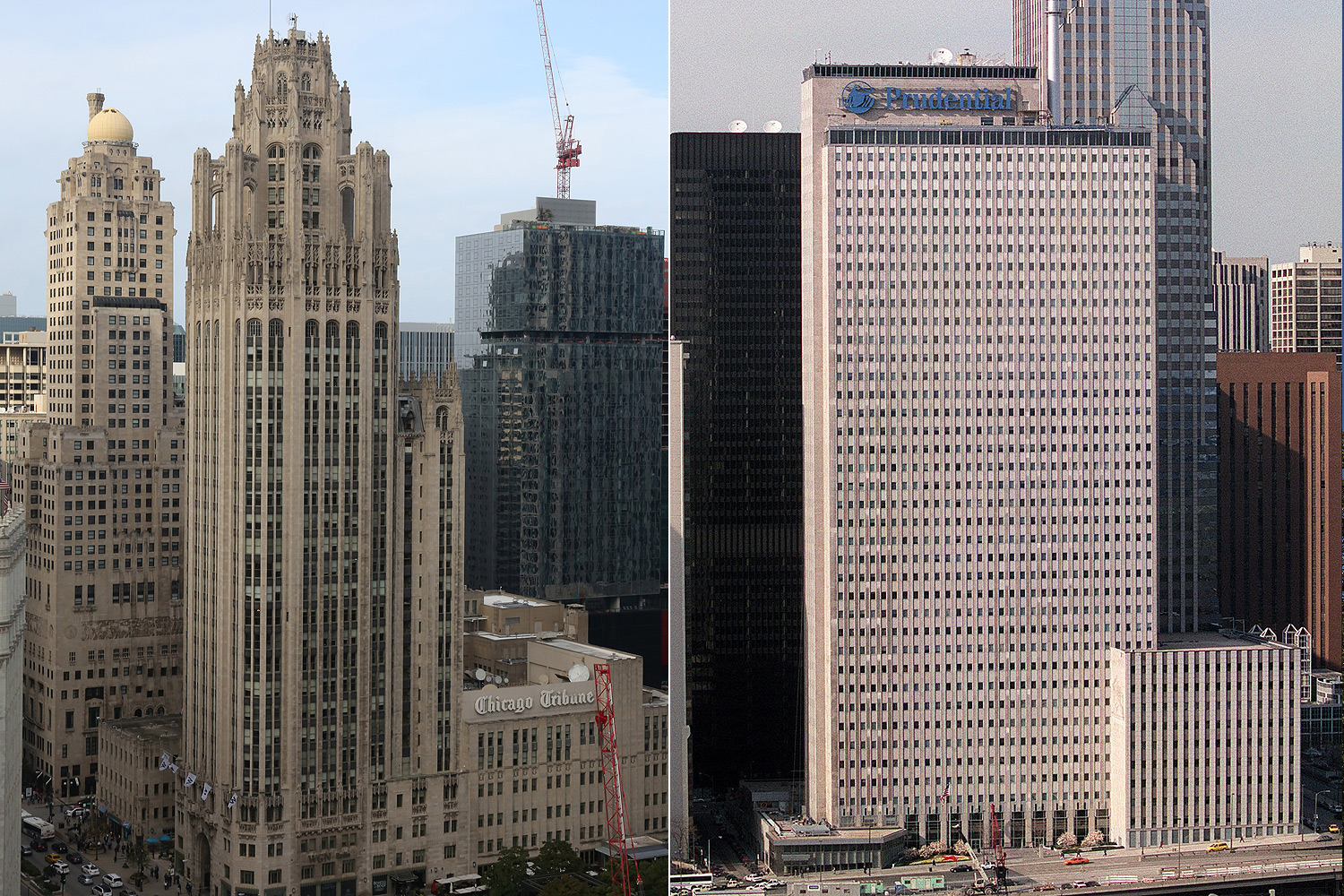It's official: three months after the Chicago Tribune's Ryan Ori broke the news, the newspaper that employs him is vacating the Tribune Tower and moving to One Prudential Plaza at 130 E. Randolph, across the street from the north end of Millennium Park, sometime in the middle of next year.
The big headline is depressing, especially if you work or have worked there. I was a Tribune intern in college. Despite my already-contrarian affection for the unloved old Sun-Times filing cabinet on the river (more on that in a bit), it was impossible to walk into the Tribune lobby without a feeling of gravity and uplift—the point, or at least the brand, of neo-Gothic architecture. True to the personality of Colonel McCormick, the lobby lays the swagger of his newspaper on thick, with inspirational quotes about the press, argument, and truth carved into the walls and fragments of great buildings embedded in the exterior, like shrapnel from history. Like a lot of the Tribune was in the early- to mid-20th century, it's a bit overbearing, but so is the responsibility of running a newspaper.
Now, to Prudential Plaza: In 1954, the Tribune asked the architects what style of the building was. They responded: "The only name for the style of the building, according to Naess & Murphy, is 'contemporary American office building.'"
It's a loss. But Prudential Plaza has a resonant history of its own, and Tribune Tower isn't the universally beloved tower that some believe it to be.
The Tribune Tower was born out of a still-legendary competition. In 1922, McCormick set out to build "the most beautiful office building in the world" and offered a prize of $50,000 for the winner, the equivalent of about $730,000 today. Some of the best architects in the world submitted designs: Walter Gropius, three years off founding the Bauhaus School; Finnish architect Eliel Saarinen, who gained stateside fame with the Bauhaus-influenced Cranbrook Educational Community in Bloomfield Hills, Michigan; the radical early modernist Adolf Loos; the approachable, utopian-minded Bruno Taut; and more.
McCormick might have gotten a submission for the most beautiful office building in the world; he got a lot of designs, some of which would predict the skyline to come. Gropius's design, Blair Kamin writes, "anticipated the steel and glass high-rises that would dominate American skylines after World War II." I can see a bit of it in Perkins and Will's Skybridge condos.
Eliel Saarinen's design finished second and earned the highest praise at the time; Louis Sullivan said it was "a voice, resonant and rich, ringing amidst the wealth and joy of life."

The Saarinen design bore some resemblance to the Howells and Hood design that won, but it stripped down the neo-Gothic frippery. In a 1954 piece, the Tribune's Chesley Manly described its crown as being "like the coiffure of a glamorous belle"—something that looks forward to the cleaner lines of modernism and art deco while blending in some Old World gravitas—perhaps why it made it as far as second in the competition. It would prove immediately influential; Howells and Hood would even go in Saarinen's direction with their 1930 Daily News building in New York.
The actual Tribune Tower doesn't look as far into the future. Sullivan torched it as "demoted to the level of those works evolved of dying ideas… this design, this imaginary building, is so helpless, so defenseless when brought face to face with mastery of ideas and validity of grounds, that it is cruel to go on, for analysis is now becoming vivisection," a "simulacrum" from "a mind unaccustomed to distinguish between architecture and scene painting." He was unusually harsh, but he wasn't alone among his contemporaries. Saarinen's design was predictive of the immediate future; Gropius and others of the distant future (Gropius's in particular could be dropped in River North today without anyone blinking an eye).
"What could Chicago have had instead of what it got—a delicate Gothic gesture to the past?" writes Duke art historian Annabel Wharton. "The corporation missed an opportunity to make a radically innovative intervention in the urban landscape, choosing instead to represent itself in the remarkably conservative and symbolically ambiguous form of a cathedral-skyscraper."
Or not that ambiguous. The Tribune Tower came after a neo-Gothic college building spree from the 1890s through 1920—like that great simulacrum, the University of Chicago—that the Atlantic's Robinson Meyer calls "continental envy." It's not that it didn't work; the University of Chicago lures students with an architecture style that immediately reads as an institution of higher learning, while Mies Van der Rohe's Illinois Institute of Technology campus is more appreciated by architects and historians than by students and locals. But in a world capital of architecture, it's a bit of a bummer. The Tribune Tower competition feels like an itch that never quite got scratched, which is perhaps why it's been famously revisited, first with Stanley Tigerman's Late Entries to the Chicago Tribune Tower Competition, then in the new Chicago Architecture Biennial.
It's not that the Tribune Tower didn't work, either: Like the University of Chicago campus, it did what it was supposed to do. It's beloved, inspiring, august, etc. But the gothic skyscraper is haunted by ghosts of what it could have been.
Prudential Plaza, on the other hand, is… prudent. It did what it was supposed to do: house an insurance company in the mid-1950s. On Twitter someone described it as "atomic age optimism," which is appropriate, as it was the city's first post-war skyscraper and its first since 1934. From 1947 to 1955, when Prudential Plaza was finished, Chicago had built less than a million feet of rentable office space, according to a 1962 report in Architectural Forum, less than a tenth of what New York City built.
"The Prudential broke the ice," a real estate agent told them. "It is doubtful that all of the subsequent buildings would have been built if Prudential had not established these things." Or as Harold Mayer and Richard Wade put it in their essential Chicago: Growth of a Metropolis, "the whole pent-up vitality of a city which had not had a major building since 1934 broke loose. Within a decade over a billion dollars was invested in new construction."
The firm that designed it, Naess and Murphy, isn't the household name that so many other Chicago firms are, but it runs through Chicago history. Architect Charles Murphy started as a stenographer with Daniel Burnham out of Northwestern. After Burnham's death, he moved up to secretary and assistant to Ernest Graham, Burnham's former assistant, who succeeded him and greatly expanded Burnham's firm, turning it into what Carl Condit calls "probably the most productive firm in the history of American architecture."
After Graham died, Murphy and two fellow associates founded Shaw, Naess & Murphy, which then became Naess and Murphy. Helmut Jahn was hired out of IIT in 1967; after he rose through the ranks, the firm became Murphy/Jahn in 1981. Jahn designed the Thompson Center in 1985, the year Murphy died; his career connects the Plan of Chicago with postmodernism, despite the fact that he never actually studied architecture.
The Prudential building was a huge commission for Naess and Murphy, and while it was subsumed by its neighbors—particularly the majestic Aon Center, completed in 1974—when it was built it was indeed built with the atomic-age optimism its midcentury looks suggest. (If it looks like Mad Men to you, well, it housed Leo Burnett for a long time.) In a 2013 piece, Lynn Becker describes the details of what was then "Chicago's prestige office address":
The Prudential was a compendium of superlatives. At 1,400 feet-per-minute, it's elevators were the world's fastest, and popping ears became standard elevator car conversation for first-time visitors. The Prudential had the biggest floor-to-floor heights. It's air conditioning capacity—3,150 tons—also set a record. Elevator service stopped at the 40th floor, and the world's tallest escalators carried visitors to the 41st floor and its observatory, which actually bested the one at the Board of Trade to become the tallest in Chicago. The panoramic views from Stouffer's Top of the Rock restaurant immediately made it a destination dining location for tourists and locals alike.
Yes, the Stouffer's of frozen-food fame, which was also a diner chain with a sideline in skyscraper lounges. Here's what it looked like (and what it looked onto) in 1957.
As you can see from the video, there wasn't much around it. But that would change. The Prudential building was built on Illinois Central air rights—Naess and Murphy were hired, according to a 1954 Tribune piece, in part for their "vast experience in complicated air rights developments"—and spurred not only the greater downtown office boom but the air-rights boom in the area. "At the time of its opening, the Prudential, in its pristine, splendid isolation, immediately became a visual anchor terminating the view north from Grant Park," Becker writes. "It was an urban signpost of the fading power of the railroads."
After the success of the Prudential Building, Naess and Murphy immediately built another major building: the home of the tough tabloid competitor to the Tribune.

In an ode to it written by Steve Rhodes for Chicago in 2004, he captured the general feelings about it, the Prudential, and Naess and Murphy:
It is part of a generation of postwar buildings that were the first significant structures built in the city since the Depression. The building’s architect, Sigurd Naess, of Naess & Murphy (which evolved out of Daniel Burnham’s firm and became Helmut Jahn’s firm), also designed the Prudential Building, which has been equally despised by architects (I happen to love the Pru). Naess was not a great architect. Carter Manny, then a young colleague, says that Naess was more of a technician than a designer. His work was not well received by up-and-coming architects in thrall to Ludwig Mies van der Rohe. “The young people in the firm were not happy with [the Sun-Times Building],” Manny recalls. “And they hadn’t been very happy with the Prudential Building. The younger people in the firm thought they were very retardare, not the best being done at the time.”
Not long arrived in Chicago, my feelings were closer to Stanley Tigerman, who described it as "that funny little fucked-up building," which was exactly right. (The critics didn't slow down the firm, though; after Naess retired in 1958, C.F. Murphy & Associates designed the Daley Center, 55 W. Wacker, McCormick Place, and others.) The Sun-Times building seemed especially fitting in the shadow of the staid Tribune Tower. "To admit this publicly will bring derision on me," Lee Bey told Rhodes, "but I will be a little sad to see it go. I've bit my tongue on this for years: I kind of like this building, and always have."
Where'd it go? Right, it's Trump Tower now.
So the Sun-Times was kicked out of a Naess and Murphy building to build deluxe apartments in the sky. Now the Tribune is being kicked into a Naess and Murphy building so that Tribune Tower can become, in all likelihood, a mixed-use building with more swank condos. Plus ça change, plus c'est la même chose.



